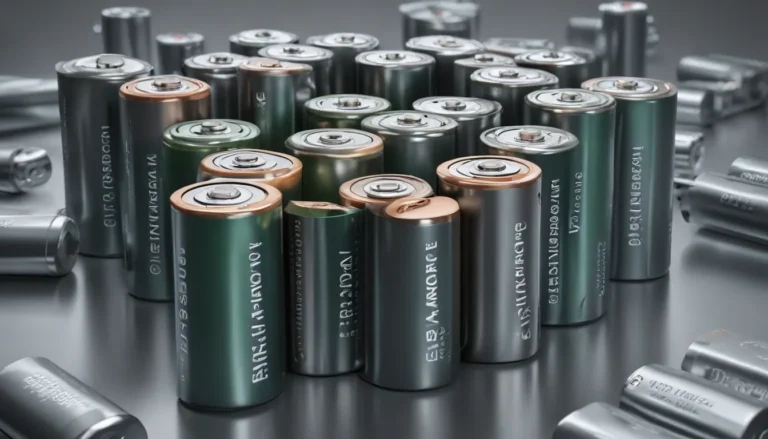A Note About Images: The images used in our articles are for illustration purposes only and may not exactly match the content. They are meant to engage readers, but the text should be relied upon for accurate information.
When it comes to the realm of semiconductors, the conversation often revolves around direct band gap semiconductors, known for their efficiency and effectiveness in electronic devices. However, lurking in the shadows are their counterparts, the indirect band gap semiconductors, which possess their own set of unique properties and applications that are equally awe-inspiring. In this article, we will delve into 17 mind-blowing facts about indirect band gap semiconductors that will leave you amazed and intrigued.
Unveiling the World of Indirect Band Gap Semiconductors
Indirect band gap semiconductors play a crucial role in the realm of technology, particularly in optoelectronic devices. Materials such as silicon and indium phosphide are often at the forefront of this technological revolution. While they have limitations in solar cell applications, ongoing research and the emergence of quantum dots aim to overcome these challenges, paving the way for enhanced performance and efficiency in various electronic applications.
Understanding Indirect Band Gap Semiconductors
An indirect band gap semiconductor is characterized by a band gap where the minimum energy level for electrons is not aligned with the maximum energy level for holes. This unique characteristic necessitates the assistance of phonons or lattice vibrations for electron transitions from the valence band to the conduction band.
The Role of Indirect Band Gap Semiconductors in Optoelectronic Devices
Widely used in optoelectronic devices such as photodiodes, LEDs, and lasers, indirect band gap semiconductors offer efficient photon emission and absorption processes. Silicon, a prominent example of an indirect band gap semiconductor, reigns supreme in the electronics industry due to its abundance and exceptional semiconductor properties.
Overcoming Limitations: The Case of Indium Phosphide
Indium phosphide (InP) stands as a testament to the prowess of indirect band gap semiconductors in high-speed electronic and optoelectronic applications. Its remarkable electrical and optical properties make it a valuable component in various technological advancements.
Quantum Dots: The Game Changer for Indirect Band Gap Semiconductors
The introduction of quantum dots, nanoscale semiconductor particles, has revolutionized the limitations faced by indirect band gap semiconductors in solar cell applications. With their unique properties, quantum dots enable enhanced light absorption and electron-hole pair generation, catapulting the performance of these materials to new heights.
Harnessing Long Carrier Lifetimes of Indirect Band Gap Semiconductors
The characteristic requirement of lattice vibrations in electron transitions offers indirect band gap semiconductors longer carrier lifetimes compared to direct band gap materials. This advantage can be harnessed in specific device applications, highlighting the versatility and potential of these semiconductors.
Gallium Antimonide: A Versatile Indirect Band Gap Semiconductor
Gallium antimonide (GaSb) emerges as a versatile compound showcasing indirect band gap behavior, finding applications in infrared detectors, lasers, and high-speed transistors. Its diverse utility underscores the importance of exploring the capabilities of such materials.
Optimizing Performance: Absorption Coefficients in Indirect Band Gap Semiconductors
Indirect band gap semiconductors are noted for their lower absorption coefficients compared to direct band gap materials. This characteristic necessitates thicker layers for light absorption, impacting their favorability in certain optical device applications.
Innovative Research for Enhanced Device Performance
Ongoing research endeavors aim to enhance the performance of devices based on indirect band gap semiconductors through the exploration of new materials, device structures, and fabrication techniques. This pursuit of excellence paves the way for groundbreaking advancements in electronic technologies.
The Thermal Frontier: High Thermal Conductivity of Indirect Band Gap Semiconductors
Certain indirect band gap semiconductors, such as diamond, exhibit higher thermal conductivity than their direct band gap counterparts. This attribute makes them ideal for high-power electronic applications where efficient heat dissipation is paramount.
Lower Radiative Recombination Rates: A Unique Trait of Indirect Band Gap Semiconductors
The radiative recombination rates in indirect band gap semiconductors are typically lower compared to direct band gap materials. This disparity can impact the efficiency of light-emitting devices, illustrating the nuanced differences between these semiconductor types.
Germanium: An Enduring Example of Indirect Band Gap Semiconductor
Germanium (Ge) remains a classic illustration of an indirect band gap semiconductor, revered for its unique properties and potential applications. Widely utilized in early electronic devices, germanium continues to be studied for its contributions to the semiconductor landscape.
High Electron Mobility: The Strength of Indirect Band Gap Semiconductors
Indirect band gap semiconductors like gallium arsenide (GaAs) boast high electron mobility, positioning them favorably for high-speed electronic applications. This capability underscores the versatility and adaptability of these semiconductors in diverse technological domains.
Essential Role in Integrated Circuits: The Influence of Silicon
Indirect band gap semiconductors like silicon form the backbone of integrated circuits (ICs), enabling the construction of transistors, diodes, and other essential electronic components. Their intrinsic properties play a pivotal role in shaping modern electronic devices.
Tailoring for Specific Applications: Engineered Indirect Band Gap Semiconductors
Through meticulous material engineering and device design, indirect band gap semiconductors can be tailored for specific applications, optimizing their performance across different wavelengths, temperatures, and power requirements. This customization opens new avenues for innovation and technological breakthroughs.
A Glimpse into the Future: Research Endeavors in Indirect Band Gap Semiconductors
The exploration of indirect band gap semiconductors remains a vibrant area of research in semiconductor physics and materials science. Scientists continue to unravel new materials and device concepts that leverage the unique properties of these semiconductors for a myriad of applications, promising exciting possibilities on the horizon.
Conclusion: Embracing the Marvels of Indirect Band Gap Semiconductors
In closing, indirect band gap semiconductors stand as marvels of technology, offering a glimpse into the intricate world of semiconductor physics and materials science. Their diverse applications, from solar cells to optoelectronic devices, underscore their indispensable role in driving technological advancements. As researchers push the boundaries and uncover new facets of these remarkable materials, we stand on the cusp of groundbreaking developments in fields such as telecommunications, energy storage, and quantum computing. The journey to uncover more mind-blowing facts about indirect band gap semiconductors beckons us to embrace the wonders of scientific exploration and innovation.
FAQs: Unveiling the Enigma of Indirect Band Gap Semiconductors
-
What exactly is an indirect band gap semiconductor?
An indirect band gap semiconductor refers to a material with a band gap where electron transitions from the valence band to the conduction band necessitate the assistance of phonons or lattice vibrations, creating unique properties and behaviors. -
What are the unique characteristics of indirect band gap semiconductors?
Indirect band gap semiconductors exhibit distinctive traits such as lower absorption coefficients, longer recombination times, and lower luminescence efficiency compared to direct band gap semiconductors, influencing their applications and performance. -
What are some applications of indirect band gap semiconductors?
Indirect band gap semiconductors find applications in optoelectronic devices like solar cells, infrared detectors, and LEDs, while also showing promise in cutting-edge fields like quantum computing, showcasing their versatility and adaptability. -
How do indirect band gap semiconductors differ from direct band gap semiconductors?
The key distinction lies in the energy transitions of electrons, where indirect band gap semiconductors require additional mechanisms for transitions, leading to unique behaviors and applications compared to direct band gap semiconductors. -
Are indirect band gap semiconductors more or less efficient than direct band gap semiconductors?
Indirect band gap semiconductors generally exhibit lower luminescence efficiency compared to direct band gap semiconductors. However, their distinctive properties, such as longer carrier lifetimes, offer advantages in specific applications, showcasing a nuanced balance of efficiency and utility.
Dive into the realm of indirect band gap semiconductors and unlock the mysteries of these fascinating materials that continue to shape the landscape of modern technology. With each discovery and innovation, we move closer to a future filled with endless possibilities and technological marvels. Join us on this captivating journey of exploration and enlightenment as we delve deeper into the enchanting world of semiconductor science and engineering.





